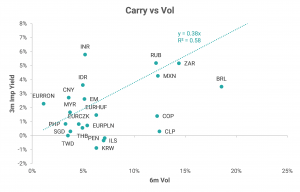Resumo do Relatório
FX Dashboard: High Volatility Relative to Carry Weighing on LatAm Currencies
With risk assets recovering this morning, the dollar index (DXY) was flat. EM currencies were similarly flat on average with no notable outliers. Overall, Latin American currencies performed better than other regions, though the difference was minor with an average appreciation of 0.1% versus -0.1% for CEEMEA and 0.0% for Asia.
Even if modest, today’s outperformance of LatAm currencies was welcome given their recent underperformance (see here). Indeed, as the first chart below shows, the volatility of LatAm currencies has picked up and is above its 10-year average. While EM currencies overall had turned more volatile a month ago, their volatility on aggregate has once again dropped below the long-term average.
Complicating the situation for the five LatAm currencies is that they offer low carry currently. As the second chart below shows, all the LatAm currencies have low carry relative to their volatilities – they are all below the best-fit regression line.
Currently, the average carry for these five LatAm currencies is 2%, which is only marginally higher than the average carry for Asian currencies. Historically, the carry difference between LatAm and Asian currencies has been high, which is reasonable to expect as LatAm currencies are typically more volatile than Asian currencies. The unprecedented level of monetary easing provided by central banks in the aftermath of the pandemic resulted in the low carry offered by most currencies, particularly LatAm currencies.
Looking ahead, of the five Latin American currencies, the Mexican peso (MXN), the Brazilian real (BRL), and the Chilean peso (CLP) are less vulnerable from this perspective. The carry for MXN is close to fair and the curve has further rate hikes priced in. In the case of BRL, the curve is pricing in almost 350 bp of additional rate hikes by the end of the year, including a hike of 75 bp likely to be delivered at the MPC meeting later today. Expectations of a strong growth rebound due to high copper prices and the rapid pace of vaccination are likely to support CLP despite its low carry.
This leaves the Peruvian sol (PEN) and the Colombian peso (COP) as the most vulnerable of the group. Continued volatility in these currencies – due to the upcoming second-round presidential election in the former and protests related to a tax reform proposal by the government in the latter – places the accommodative monetary policies in the two countries at risk. Colombia’s Banco de la República said as much in their statement last week.
This is particularly notable for Colombia as we have held the view that there was room to ease (see here). The recent spate of volatility has changed our view and even though there was a split vote at the MPC meeting last week with 1 vote for a rate cut, we now don’t think a rate cut is likely. At best, the central bank may delay rate hikes. Given the rise in risk to the short end of the curve on the back of recent events, we recommend closing the 5s10s curve steepener recommendation we had in Colombia with a small profit.


Data Source: Refinitiv; Note: EM and LatAm refer to equally weighted spot returns for 22 EM and 5 LatAm currencies, respectively
Best Longs / Best Shorts
- To the list of underperformers based on our models in the attached FX Dashboard, we added the Colombian peso (COP) as its average z-score based on 3m changes exceeded 1.
- The Peruvian sol (PEN), the Thai baht (THB), and the Romanian leu against the euro (EURRON) were on the list already.
- The list of outperformers stayed unchanged with the Chilean peso (CLP) on it.
Best Crosses
- Our list of preferred relative-value trades remain unchanged with Long COP vs Short CLP or ZAR and Long PEN vs Short CLP on it.
- The 3m expected returns for these pairs are high in the range of 10-12% (not annualized), assuming mean reversion.
Aviso legal
DISCLAIMER: Este Relatório de Análise foi elaborado e distribuído pelo Analista, signatário unicamente para uso do destinatário original, de acordo com todas as exigências previstas na Resolução CVM nº 20 de 26 de fevereiro de 2021 e tem como objetivo fornecer informações que possam auxiliar o investidor a tomar sua própria decisão de investimento, não constituindo qualquer tipo de oferta ou solicitação de compra e/ou venda de qualquer produto. As decisões de investimentos e estratégias financeiras devem ser realizadas pelo próprio leitor, os Analistas, ou a OHMRESEARCH não se responsabilizam por elas. Os produtos apresentados neste relatório podem não ser adequados para todos os tipos de investidores. Antes de qualquer decisão de investimentos, os investidores deverão realizar o processo de suitability no agente de distribuição de sua confiança e confirmar se os produtos apresentados são indicados para o seu perfil de investidor. A rentabilidade de produtos financeiros pode apresentar variações e seu preço ou valor pode aumentar ou diminuir num curto espaço de tempo. Os desempenhos anteriores não são necessariamente indicativos de resultados futuros. A rentabilidade divulgada não é líquida de impostos. As informações presentes neste material são baseadas em simulações e os resultados reais poderão ser significativamente diferentes.
O(s) signatário(s) deste relatório declara(m) que as recomendações refletem única e exclusivamente suas análises e opiniões pessoais, que foram produzidas de forma totalmente independente e que a OHMRESEARCH não tem qualquer gerência sobre este conteúdo. As opiniões aqui expressas estão sujeitas a modificações sem aviso prévio em decorrência de alterações nas condições de mercado. O Analista responsável pelo conteúdo deste relatório e pelo cumprimento da Resolução CVM nº 20/21 está indicado acima, sendo que, caso constem a indicação de mais um analista no relatório, o responsável será o primeiro analista credenciado a ser mencionado no relatório. Os analistas cadastrados na OHMRESEARCH estão obrigados ao cumprimento de todas as regras previstas no Código de Conduta da APIMEC para o Analista de Valores Mobiliários e no Manual de Controles Internos para Elaboração e Publicação de Relatórios da OHMRESEARCH. De acordo com o art. 21 da Resolução CVM nº 20/21 caso o Analista esteja em situação que possa afetar a imparcialidade do relatório ou que configure ou possa configurar conflito de interesse, este fato deverá estar explicitado no campo “Conflitos de Interesse” deste relatório.
O conteúdo deste relatório é de propriedade única do Analista signatário e não pode ser copiado, reproduzido ou distribuído, no todo ou em parte, a terceiros, sem prévia e expressa autorização deste Analista. Todas as informações utilizadas neste documento foram redigidas com base em informações públicas, de fontes consideradas fidedignas. Embora tenham sido tomadas todas as medidas razoáveis para assegurar que as informações aqui contidas não são incertas ou equívocas no momento de sua publicação, o Analista não responde pela veracidade das informações do conteúdo.
Para maiores informações, pode-se ler a Resolução CVM nº 20/21 e o Código de Conduta da APIMEC para o Analista de Valores Mobiliários. Este relatório é destinado exclusivamente ao assinante da OHMRESEARCH que o contratou. A sua reprodução ou distribuição não autorizada, sob qualquer forma, no todo ou em parte, implicará em sanções cíveis e criminais cabíveis, incluindo a obrigação de reparação de todas as perdas e danos causados, nos termos da Lei nº 9.610/98 e de outras aplicáveis.





